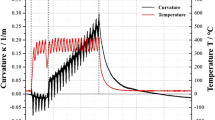Abstract
Suspension plasma spray (SPS) is far more complicated than conventional plasma spray and requires a deep knowledge about the influence of process parameters and their correlations. In this study, YSZ coatings were manufactured by SPS with six different process parameters such as plasma power, suspension mass load, original powder size, substrate surface topology, spray distance, and spray step. Afterward, the porosity of as-prepared coatings was investigated by image method and x-ray transmission technique. A multivariate analysis on the collected experimental data was carried out by employing mathematical statistics methods. The results showed that: (1) coating porosity has a negative correlation with plasma power and suspension mass load and a positive correlation with the original powder size, spray distance, spray step, and substrate roughness; (2) spraying distance is the main factor affecting to coating porosity, followed by suspension mass load and substrate surface roughness, respectively. A linear model for porosity prediction was developed and was verified by experiments. The mechanism by which process parameters influence coating porosity is also discussed.







Similar content being viewed by others
References
A. Vardelle, C. Moreau, J. Akedo, H. Ashrafizadeh, C.C. Berndt, J.O. Berghaus, M. Boulos, J. Brogan, A.C. Bourtsalas, A. Dolatabadi, M. Dorfman, T.J. Eden, P. Fauchais, G. Fisher, F. Gaertner, M. Gindrat, R. Henne, M. Hyland, E. Irissou, E.H. Jordan, K.A. Khor, A. Killinger, Y.-C. Lau, C.-J. Li, L. Li, J. Longtin, N. Markocsan, P.J. Masset, J. Matejicek, G. Mauer, A. McDonald, J. Mostaghimi, S. Sampath, G. Schiller, K. Shinoda, M.F. Smith, A.A. Syed, N.J. Themelis, F.-L. Toma, J.P. Trelles, R. Vassen, and P. Vuoristo, The 2016 Thermal Spray Roadmap, J. Therm. Spray Technol., 2016, 25(8), p 1376-1440
U. Klement, J. Ekberg, and S.T. Kelly, 3D Analysis of Porosity in a Ceramic Coating Using X-ray Microscopy, J. Therm. Spray Technol., 2017, 26, p 456-463
C. Zhao, R. Liu, S. Wang, Z. Wang, J. Qian, and T. Wen, Fabrication and Characterization of a Cathode-Supported Tubular Solid Oxide Fuel Cell, J. Power Sour., 2009, 192(2), p 552-555
B. Zhao, Y. Tong, Y. Zhao, T. Yang, F. Yang, Q. Hu, and C. Zhao, Preparation of Ultra-Fine Sm0.2Ce0.8O1.9 Powder by a Novel Solid State Reaction and Fabrication of Dense Sm0.2Ce0.8O1.9 Electrolyte Film, Ceram. Int., 2015, 41(8), p 9686-9691
F. Cernuschi, S. Ahmaniemi, P. Vuoristo, and T. Mantyla, Modelling of Thermal Conductivity of Porous Materials: Application to Thick Thermal Barrier Coatings, J. Eur. Ceram. Soc., 2004, 24, p 2657-2667
S. Sathish, M. Geetha, S.T. Aruna, N. Balaji, K.S. Rajam, and R. Asokamani, Sliding Wear Behavior of Plasma Sprayed Nanoceramic Coatings for Biomedical Applications, Wear, 2011, 271(5), p 934-941
L. Pawlowski, Suspension and Solution Thermal Spray Coatings, Surf. Coat. Technol., 2009, 203(19), p 2807-2829
P. Fauchais, V. Rat, J.-F. Coudert, R. Etchart-Salas, and G. Montavon, Operating Parameters for Suspension and Solution Plasma-Spray Coatings, Surf. Coat. Technol., 2008, 202(18), p 4309-4317
Y. Zhao, Z. Yu, M.P. Planche, A. Lasalle, A. Allimant, G. Montavon, and H. Liao, Influence of Substrate Properties on the Formation of Suspension Plasma Sprayed Coatings, J. Therm. Spray Technol., 2018, 27(1), p 73-83
T. Tesar, R. Musalek, J. Medricky, J. Kotlan, F. Lukac, Z. Pala, P. Ctibor, T. Chraska, S. Houdkova, V. Rimal, and N. Curry, Development of Suspension Plasma Sprayed Alumina Coatings with High Enthalpy Plasma Torch, 2017, Surf. Coatings Technol., 2017, 325, p 277-288
G. Darut, H. Ageorges, A. Denoirjean, and P. Fauchais, Tribological Performances of YSZ Composite Coatings Manufactured by Suspension Plasma Spraying, Surf. Coat. Technol., 2013, 217, p 172-180
S.H. Seyedin, E. Zhalehrajabi, M. Ardjmand, A.A. Safekordi, S. Raygan, and N. Rahmanian, Using Response Surface Methodology to Optimize the Operating Parameters in a Top-Spray Fluidized Bed Coating System, Surf. Coat. Technol., 2018, 334(Supplement C), p 43-49
N.H.N. Yusoff, M.J. Ghazali, M.C. Isa, A.R. Daud, A. Muchtar, and S.M. Forghani, Optimization of Plasma Spray Parameters on the Mechanical Properties of Agglomerated Al2O3–13%TiO2 Coated Mild Steel, Mater. Des., 2012, 39(Supplement C), p 504-508
J.O. Oji, P.H. Sunday, O.M. Petinrin, and A.R. Adetunji, Taguchi Optimization of Process Parameters on the Hardness and Impact Energy of Aluminium Alloy Sand Castings, Leonardo J. Sci., 2013, 23, p 1-12
G. Taguchi, Introduction to Quality Engineering: Designing Quality into Products and Processes, Tokyo, APO, 1986, p 1-200
M.S. Phadke, Quality Engineering Using Robust Design, Prentice Hall PTR, New Jersey, 1995, p 41-66
R.K. Roy, Design of Experiments Using the Taguchi Approach: 16 Steps to Product and Process Improvement, Wiley, New York, 2001, p 8-24
R.K. Roy, A Primer on the Taguchi Method, Society of Manufacturing Engineers, 2010, p 261-293
D.T. Cromer and D.A. Liberman, Anomalous Dispersion Calculations Near to and on the Long-Wavelength Side of an Absorption Edge, Acta Cryst., 1981, A37, p 267-268
R. Scaffaro, F. Sutera, and F. Lopresti, Using Taguchi Method for the Optimization of Processing Variables to Prepare Porous Scaffolds by Combined Melt Mixing/Particulate Leaching, Mater. Des., 2017, 131(Supplement C), p 334-342
E. Aubignat, M.P. Planche, A. Allimant, D. Billières, L. Girardot, Y. Bailly, and G. Montavon, Effect of Suspension Characteristics on In-Flight Particle Properties and Coating Microstructures Achieved by Suspension Plasma Spray, J. Phys: Conf. Ser., 2014, 550(1), p 012-019
Acknowledgments
This research used resources of the Advanced Photon Source, a US Department of Energy (DOE) Office of Science User Facility operated for the DOE Office of Science by Argonne National Laboratory under Contract No. DE-AC02-06CH11357.
Author information
Authors and Affiliations
Corresponding author
Additional information
This article is an invited paper selected from presentations at the 2018 International Thermal Spray Conference, held May 7-10, 2018, in Orlando, Florida, USA, and has been expanded from the original presentation.
Rights and permissions
About this article
Cite this article
Zhao, Y., Peyraut, F., Planche, MP. et al. Experiments, Statistical Analysis, and Modeling to Evaluate the Porosity Influence in SPS Coatings. J Therm Spray Tech 28, 76–86 (2019). https://doi.org/10.1007/s11666-018-0749-4
Received:
Revised:
Published:
Issue Date:
DOI: https://doi.org/10.1007/s11666-018-0749-4




